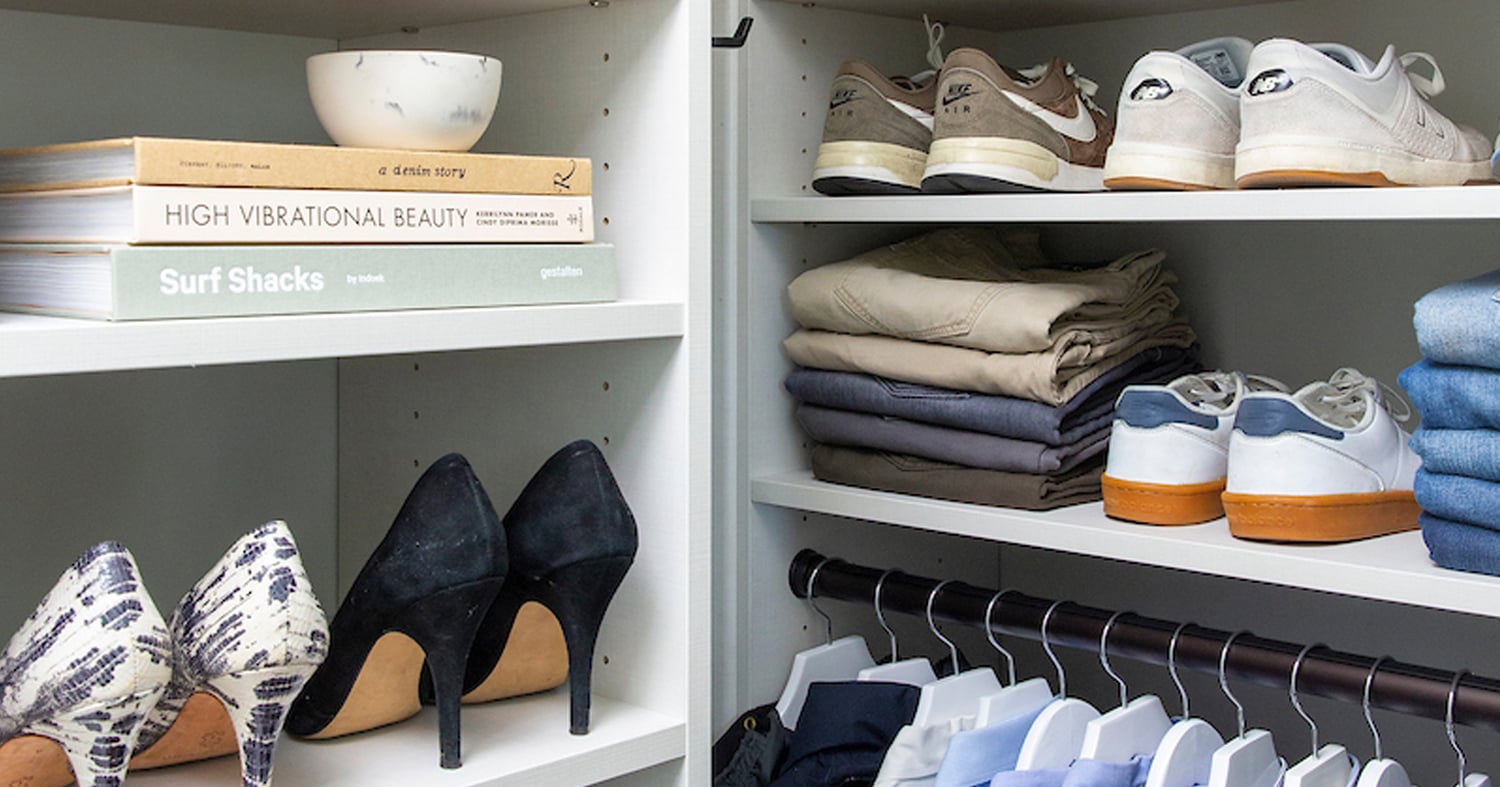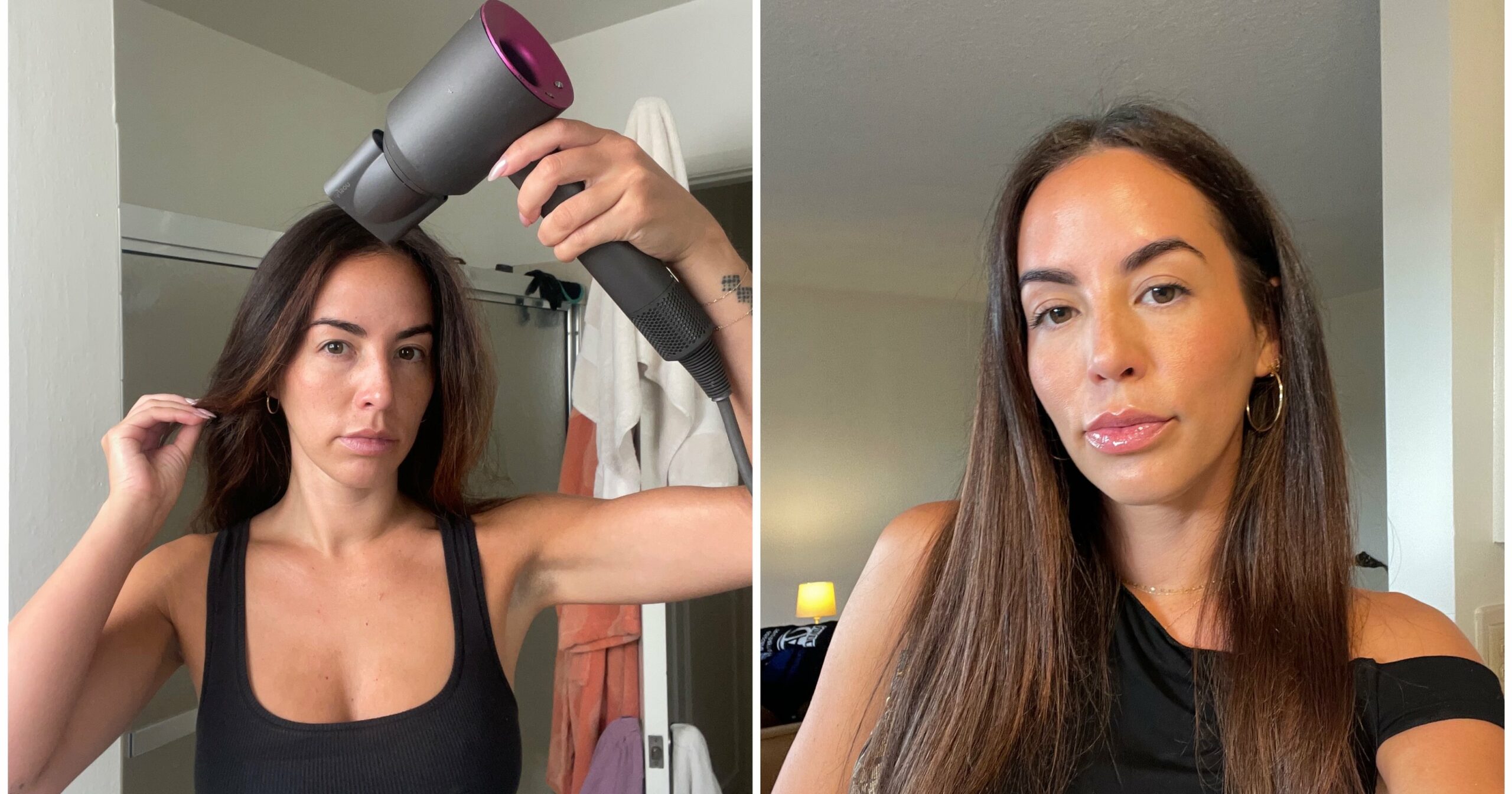As a professional organizer, I’ve spent over a decade helping people overhaul and transform their closets. I’ve organized every size, style, and type of closet you can imagine, and I also share a three-by-six-foot closet with my husband, Jordan, who really loves sneakers.
Figuring out how to organize a small closet, especially if you have lots of clothes, can present a whole host of challenges, but I truly believe that – with a little creativity – even the smallest sliver of space can be transformed into a functional area you actually love. I’m rounding up my best actionable small closet organization tips to help you maximize even the tiniest space. Let’s dive in.
25 Small Closet Organization Tips
1. Relocate the Randoms
Closets can easily become a magnet for clutter, but they should ideally be reserved for shoes, clothing, and accessories. Take a few minutes to relocate any random items that don’t belong in your closet or could live elsewhere. Common culprits include old receipts, extra bedding, wrapping paper, kids’ belongings, art, important documents, and sentimental items like memorabilia.
2. Edit Your Face Off
This tip might make you want to hurl a shoe at me, but I promise it’s true: the number one way to instantly improve the look, feel, and function of your space is simply to own less stuff. My favorite motto here is “all killer, no filler.”
Since your closet’s contents ultimately determine your style, this is a great opportunity to become more intentional about how you present yourself. Just because something cost a lot, or looks amazing on someone else, doesn’t mean it’s right for you. Think of your closet as a well-curated boutique, and only fill it with items you truly love that reflect your authentic style. If you get stuck, try my favorite editing prompts:
- Would I buy this item today at full price?
- Does this item fit and flatter my current body?
- Is this item adding value or clutter to my life?
- Is this item worth the space it’s taking up in my closet?
Pro tip: Consider curating a capsule wardrobe with a limited selection of high-quality, versatile pieces you wear on repeat. Less clothing means less clutter, and you’ll always have something you love to wear.
3. Re-Home Rarely Used Items
Have items you want to keep but rarely wear? Think: the little black dress you only wear to formal events, bulky ski pants, or that mermaid costume you pull out once a year. These items may be taking up valuable space in your closet and can be relocated to a storage closet, under-the-bed storage box, or packed in a weatherproof garment bag in the garage, attic, or basement.
4. Rotate Out-of-Season Clothes
Rotate out-of-season clothes, like heavy winter coats or light summer sundresses, into other storage locations when they are unneeded. Store them in breathable garment bags and tuck them under the bed or in any available deep storage area in your home.
5. Go Vertical
The number one investment I suggest for every closet? More shelves! While there are great closet organization systems out there, you don’t need an expensive system or remodel – you can double your storage space by adding a few rows of wall-mounted shelves. Use them to line up shoes, store handbags, or stow folded sweaters, jeans, or tees. Vertical space is your friend.
6. Add a Floating Shelf For Luggage
Luggage can be a beast to store and is only occasionally used by most people, so try nesting it in unused space by installing a sturdy floating shelf above your closet door or at the tippy-top of your wall near the ceiling.
7. Stack It Up
Stackable bins are perfect for grab-and-go items like belts, scarves, or workout gear. Place them on your closet floor or highest shelf to maximize space, or even under your bed if your closet can’t accommodate them.
8. Prioritize Accessibility
Place your most frequently worn items front and center, where they’re easiest to reach. Reserve harder-to-reach spots, like the top shelf corner, for items you wear less frequently (or your luggage). If you’re worried you will forget about the things you wear less frequently that are not front and center, maybe it’s a sign that you should donate them?
9. Hooks Solve Everything
Hooks are one of my top organizing tools because they’re small, sturdy, and wildly versatile. Mount a few attractive hooks in your closet for robes, hats, bags, belts, or even jewelry. Metal S-hooks work great for hanging jeans by the belt loop or bags by their straps. A strategically placed hook on the back of your closet door can add an option for longer items like dresses or coats that might not have room to comfortably hang elsewhere.
10. Invest in Slim Profile Hangers
Good hangers can last you a lifetime and instantly elevate your closet. Don’t skimp here: look for sturdy and stylish slim-profile hangers (I prefer wood, which are more sustainable and rarely break).
Pro tip: Multi-tiered hangers can exponentially increase your hanging storage.
11. Try a Basket
In a small closet, every inch counts. If you’re out of shelf or rod space, try adding a floor basket to corral items like slides, mules, flip-flops, scarves, swimsuits, or workout gear.
12. Utilize the Back of the Door
Over-the-door storage organizers aren’t just for shoes! You can use them to store scarves, accessories, socks, underwear, tanks, and tees. But they are also truly an easy way to have both shoe options and shelf space.
13. Drawer Dividers For the Win
If your closet has drawers, drawer dividers are a game changer. Use them to separate socks, bras, underwear, or small accessories like belts or scarves, maximizing every square inch.
14. Get Creative With Furniture
If your tiny closet is maxed out, consider using a cart, rolling rack, dresser, or bookshelf for extra storage. Small bookshelves can showcase shoes, bags, and accessories, while rolling carts or dressers are perfect for organizing basics like workout gear, loungewear, and pajamas. Think outside the box – I have a client who stores her socks, underwear, and scarves in a hanging three-tier fruit basket. Brilliant!
15. Add Shelf Dividers
Clip-on shelf dividers help create boundaries between items and prevent piles of folded clothes from toppling over.
16. Use Shelf Risers
Shelf risers make use of wasted vertical space, allowing you to stack items like shoes or folded clothes while keeping everything organized and visible.
17. Repurpose a Bookend
Line up clutches, bags, and wallets by size, and use a bookend to keep them from toppling. A letter organizer can also work as storage for small clutches and wallets.
18. Install a Second Rod
Maximize vertical space by installing a second rod. Use the top rod for longer items like dresses or coats and the bottom for shorter items like pants or skirts.
19. Treat Yourself to a Valet Rod
Compact (and retractable) valet rods are a space-efficient little luxury for staging outfits or organizing while packing for a trip. Plus, it will make you feel like you’re staying at a fancy hotel.
20. Light It Up
A well-lit closet makes a world of difference. Add battery-powered LED light strips, puck lights, or motion-sensor lights to illuminate dark corners and help you find what you need faster.
21. “File Fold” Your Clothes
Instead of stacking folded clothes, try the “file fold” method for items like t-shirts, jeans, and sweaters. This lets you see every item at a glance and prevents piles from toppling.
22. Color-Coding Is Your Friend
There’s a good reason professional organizers color-code wardrobes. Grouping items by type and color makes it easy to find what you need in seconds. (There’s that pink blouse I was looking for!)
23. Just Add Labels
If you’re using bins or boxes for storage, label them to keep things organized long-term. Clear, simple labeling helps you (and others) maintain order.
24. Elevate With Some Simple Style Upgrades
Even the tiniest space can be elevated with a fresh coat of paint (or wallpaper), a new light fixture, and thoughtful details. Style it like a boutique by swapping in accessories you already own, like design books, votive candles, or vintage throw rugs.
25. Practice the One-In-One-Out Rule
To keep your closet looking sharp, respect the boundaries you’ve established. When you add something new, donate or consign a similar piece. Keep a basket or tote in your closet to collect the items you plan to donate. When it’s full, take it to a donation center or consignment store (that day – do not let your trunk become a mobile donation center).
Remember, life can be chaotic, but your closet doesn’t have to be.
Shira Gill is a globally recognized home-organizing expert and author with a minimalist philosophy. She’s inspired thousands of people to clear clutter from their homes and lives through a process she developed that applies to anyone, regardless of budget, space, or lifestyle. Shira is the bestselling author of “Minimalista,” “Organized Living,” and her forthcoming book “LifeStyled,” and has been featured by 100+ media outlets. Shira is a PS Council member.




